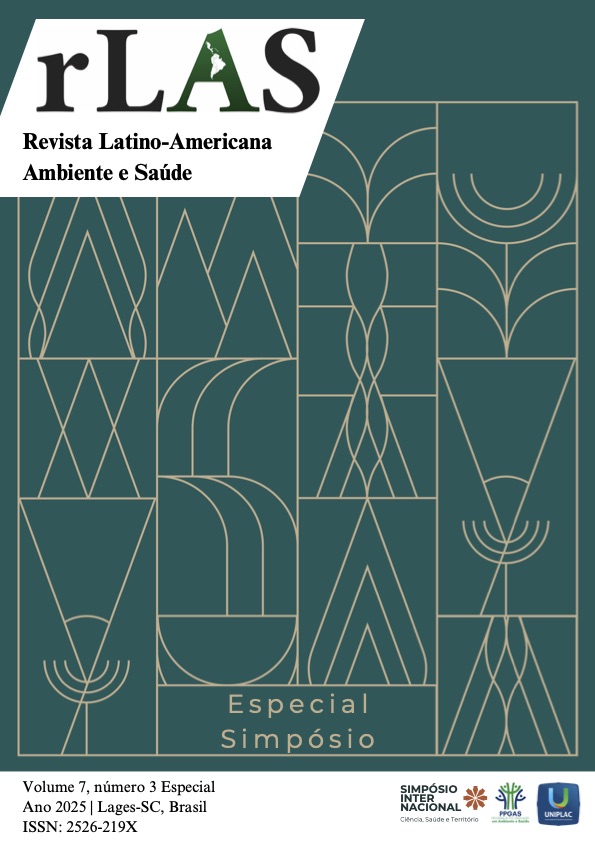Impacts of the element fluorine: bibliographical review
Keywords:
fluorine, toxicity, ecosystemAbstract
The objective of this study was to conduct a literature review to highlight the negative impacts that fluorine toxicity can cause on the atmosphere, plants, animals and soil. Growing industrial production is considered one of the main sources of fluorine emissions into the atmosphere, such as the production of phosphate fertilizers. Plants absorb fluorine through their leaves, and after toxicity they may show reduced growth and loss of agricultural production. Some species are used as bioindicators to help monitor contamination levels. Fluorine poisoning in animals usually occurs in a chronic or subacute form, and rarely occurs in an acute form. Symptoms caused in animals by excess fluorine include fluorosis, which presents stains on the teeth and deformities in the enamel. In the soil, fluorine pollution is present in the colloidal or clay fraction of the soil, indirectly modifying soil properties. Therefore, it is necessary to understand the negative effects that fluorine toxicity causes to ecosystems, so that research and technical work can be carried out with the aim of minimizing these impacts.
References
ADAMS, D.F.; HENDRIX, J.W.; APPLEGATE, H.G. Relationship among exposure periods, foliar burn, and fluorine content of plants exposed to hydrogen fluoride. Journal of Agricultural and Food Chemistry, Easton, v.5, p.108-116, 1957
ANDRIGUETTO et al. Nutrição Animal. 4.ed. São Paulo: Nobel, 1999. p. 396.
ARNDT, U.; FLORES, F.; WEINSTEIN, L. Efeitos do flúor sobre as plantas: diagnose de danos da vegetação do Brasil. Porto Alegre: UFRGS, 1995. p.155.
ALLOWAY, B.J.; AYRES, D.C. Chemical Principles of Environmental Pollution. Water, Air and Soil Pollution, Dordrecht, v.102, p.216-218, 1998.
BRAEN, S.N.; WEINSTEIN, L.H. Uptake of fluoride and aluminum by plants grow in contaminated soils. Water, Air and Soil Pollution, Dordrecht, v.24, p.215-223, 1985
BOMBIK E. et al. O efeito da contaminação ambiental por compostos de flúor em tecidos selecionados de cavalos. Polish Journal of Environmental Studies, v.20, n.1, p.37–43, 2011.
BUNCE, H.W.F. Fluoride emissions and florest survival; growth and regeneration. Environmental Pollution Series A, Ecological and Biological, v.35, p.169-188, 1984
CHAVES, A.L.F. et al. Ação do flúor dissolvido m chuva simulada sobre a estrutura foliar de Panicum maximum (colonião) e Chloris gayana Kunth. (capim-rhodes) - Poacea. Acta Botânica Brasilica, Porto Alegre, v.16, p.395-406, 2002
CRONIN, S.J. et al. Fluoride: a review of its fate, bioavailability, and risks of fluorosis in grazed-pasture systems in New Zealand. New Zealand Journal of Agricultural Research, Wellington, v.43, p.295-321, 2001.
FERRARI, K.R. et al. Determinação das Emissões de Fluoreto Durante a Queima de Amostras de Massas Cerâmicas, Cerâmica Industrial, 8 (5/6) Setembro/Dezembro, 2003
MIRLEAN, N.; CASARTELLI, M. R.; GARCIA, M. R. D. Propagação da poluição atmosférica por flúor nas águas subterrâneas e solos de regiões próximas às indústrias de fertilizantes (Rio Grande, RS). Química Nova, v. 25, p. 191-195, 2002
GRZEGORZEK, M.; MAJEWSKA-NOWAK K.; AHMED, A. E. Removal of fluoride from multicomponent water solutions with the use of monovalent selective ion-exchange membranes. Science of The Total Environment, v.722, n.20, p.137681, 2020.
SUPHARUNGSUN, S.; WAINWRIGHT, M. Determination, distribution, and absorption of fluoride in atmospheric-polluted soils, Bulletin of Environmental Contamination and Toxicology, New York, v.28, p.632-636, 1982.
WEINSTEIN, L.H.; DAVISON, A.W. Native plant species suitable as bioindicators and biomonitors for airborne fluoride. Environmental Pollution, Barking, v.125, p.3-11, 2003.
WEINSTEIN, L.H.; DAVISON, A. Fluoride in the environment. London: Cabi, 2004. 287p


